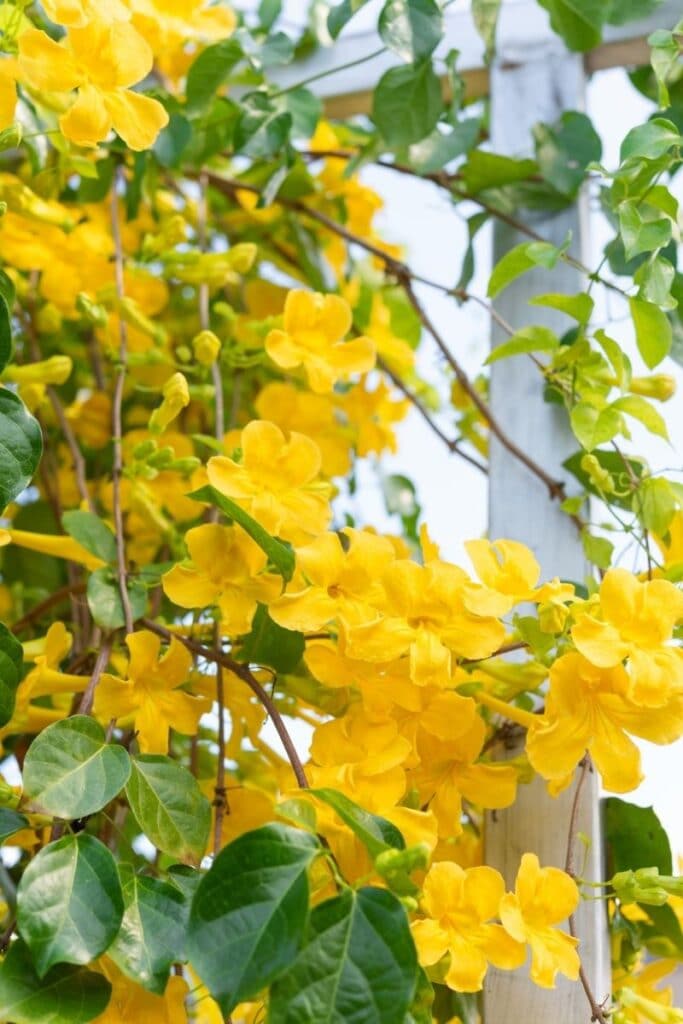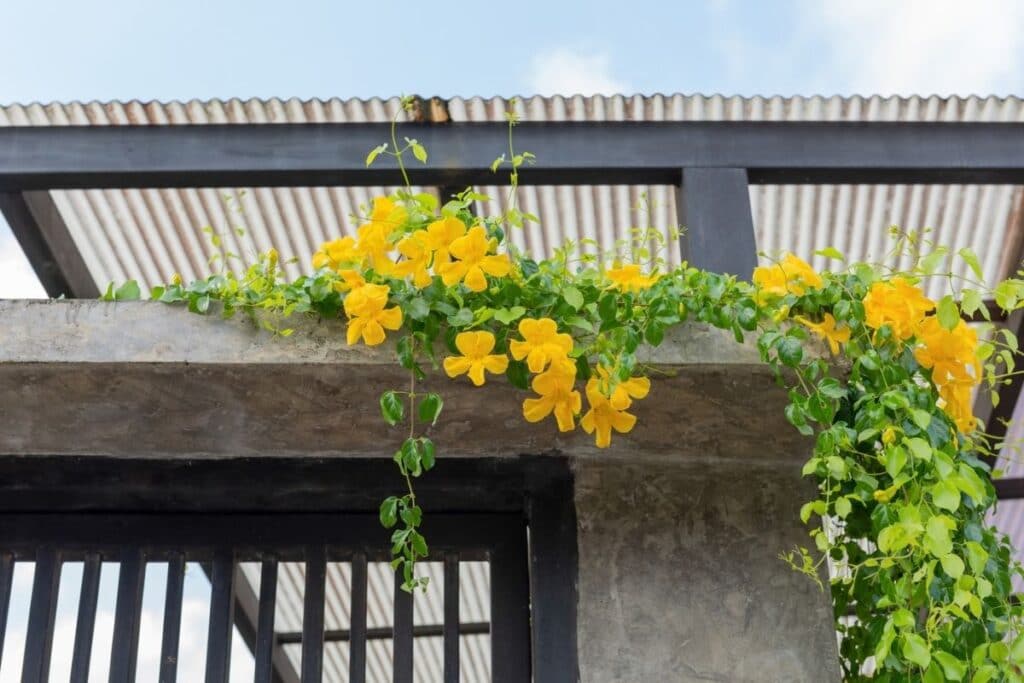For growers who are looking for plants that have unique structures and at the same time will add a pop of color to the landscape, the Cat’s Claw Vine is a perfect choice.
This vine will add a pop of yellow to the landscape and may serve as a screen or shade, given the right supporting structures. Despite its aesthetic qualities and functionality, this vine brings potential harm of invasion for the landscape.
Botanical Information
The Cat’s Claw Vine is also identified as the cat’s claw trumpet, funnel creeper, and cat’s claw creeper because of its morphology. In scientific literature, this plant is known as Dolichandra unguis-cati, which is also synonymous with Macfadyena unguis-cati.
Coming from the Bignoniaceae family, this plant also shares the same characteristics in the family such as large showy flowers and long-stemmed woody vine.
Spatial distribution
In the Yucatan Peninsula, Mexico is where this vine originated but is also present in Central America, Argentina, and South America. It was introduced and naturalized in Hawaii, Texas, Florida, South Africa, and some areas in Australia. Due to its origin, the said plant thrives in USDA Zones 9 to 11.

Leaves
Surrounding its long woody stem are leaves that are compound opposite and are composed of two leaflets. Each leaflet matures and becomes dark green, ovate shaped with entire margins. The Cat’s Claw Vine got its name from its tendrils, a specialized stem that functions as the plant’s anchorage.
The tendrils come with three small claw-like structures protruding on the axillary parts of vegetative growth. This specialized “claw” makes it easier for the plant to cling to structures and optimize growth.
Flowers
Since it came from a family of showy flowers, this vine produces bright yellow tubular flowers, which is an amalgamation of five petals with 2 upper lobes and 3 on the lower side.
A congregation of its trumpet shaped flowers is often seen on axillary parts of the plant. Flower season starts during the early days of Spring and sometimes continues to flourish until Summer.
Fruit and Seeds
At the fruit set, the flowers dry up and give rise to flat linear pods that extend up to 20 inches in length. There are roughly 50 seeds inside each pod. The seeds are winged and oblong with the dimensions 4 cm in length, 1 cm in width, and a few millimeters thick. Due to the seed’s structure, it is often easily spread by wind and water.
Growth and Development
Depending on the plant’s function, it is grown as a perennial woody vine or a shrub. Like a vine, the supporting structure is its height limit as it often grows up to a hundred feet.
Identification of this plant during its young stage is tricky as it can appear as a unifoliate and tendrils are not prominent, commonly referred to as the “simple-leaved phase”. This phase tends to be destructive as it can stay that way for years and keep on covering horizontal space, making it hard for other plants to grow. After storing enough food and water, the Cat’s Claw Trumpet will start the climb on nearby structures.
As one of the plants that grow in full sun, flowers are often seen on the upper parts of the canopy. In forests, flowers are often above eye level as they grow towards the sun’s direction. In an undisturbed ecosystem, this vine drops its flowers and seeds as its mode of reproduction.
Cat’s Claw Vine Look-Alikes
Yellow Jessamine
The Yellow Jessamine or Gelsemium sempervirens is similar to the Cat’s Claw Vine because of their long yellow flowers, leaves, and growth habit. However, the Yellow Jessamine has simple leaves with a single blade in comparison to the Cat’s Claw Trumpet’s two leaflets and claw-like tendrils.
Yellow Elder
As one of the Cat’s Claw vine looks alike, the Yellow Elder or Tecoma stans belong to the same family hence their resemblance. Although, they tend to differ in leaf structure as the Yellow Elder have elliptical and serrated leaves.

How to grow cats claw vine
Sun Requirement
This high climbing woody vine loves to be exposed under full to partial sun.. It is crucial for its flowering to have at least 6 continuous hours of full sun.
Water Requirement
At its young age, watering frequently for about 2 to 3 times a week is recommended until the plant becomes established.
Plants largely take care of themselves until they reach maturity, with the exception of the occasional watering. Checking the plant and soil state regularly will help determine the amount of moisture to be applied.
Temperature and Humidity Requirement
As a sun-loving plant, the Cat’s Claw Vine is heat-loving and drought tolerant. On the other hand, cold seasons are not in favor of this vine’s flowering and growth may be stagnant.
Fertilizer
Fertilizer application is done as needed by the plant. Nitrogen-rich fertilizers will promote more foliage growth while phosphorus-rich fertilizer favors flowering. Remember to apply the right amount of product as stated in its packaging to avoid soil toxicity.
Soil Requirement
This aggressively growing plant is not a picky grower in terms of where it is planted. The vines tend to prefer moist and well drained soil.
Propagation
The Cat’s Claw plant easily reproduces thanks to its seeds found inside its seed pods, making it easily disseminated by water and air. Furthermore, the vine may also be propagated through its cuttings and tuberous roots.
The time of planting will play a huge role in the success of this vine’s growth. Planting in late spring or early fall is the most suitable time. Another important factor for this plant’s growth is location, making sure that there is enough room for growth where the roots and stems freely develop.
Dugout a hole thrice the size of the plant’s root ball and apply some compost. Water regularly for 2 to 3 times a week and mulch may be added. The mulch should be at most 5 cm thick and 10 cm away from the main stem, this distance serves as a precautionary measure for possible stem rot.
Trimming
This maintenance activity is done as often as needed to keep the plant free of dead parts, which lessen its susceptibility to any disease. Training the vine is also done to make sure that it will not cause havoc in the landscape and harm other existing vegetation.
Landscape Use
In the landscape, the Cat’s Claw Trumpet is often used to soften some man-made structures and add a pop of color. They are often left to crawl and twine on old barks, trellises, arbors, and fences.
Training them to be in a specific shape and form will make them good topiaries and specimen plants. Along with training them, providing the right structures to support the desired shape is recommended. Training this vine entails more laborious maintenance to keep its form and aesthetic.
Potential Harm Caused by Cat’s Claw Plants
Potential Harm
The Cat’s Claw Trumpet is classified as an invasive species in some areas due to its extensive underground tubers and grows quickly. It is also generally not a picky plant that can survive in most environments. Cat’s claw vines may grow into dense mats that carpet the forest floor, causing native plant groups to change.
They proliferate in areas near river or stream banks, near human habitations, and in undisturbed hammocks. In Florida, this vine is classified as one of the hardest vines to control due to its rigorously growing root system.
The Florida Exotic Pest Plant Council had the vine listed as a Category I invasive plant and the UF/IFAS put it under the high invasion risk category. Given these premises, taking care of the Cat’s Claw plant will give an additional ecological responsibility for the grower.
Control
If not wanted in the landscape, removal of the vine is suggested by uprooting the plant when they are still in small amounts. Uprooting, cutting, and mowing may be a repetitive activity to keep the landscape cat’s claw trumpet free. If mechanical methods are too troublesome, the application of chemicals may be used with caution.
After cutting the vines, painting the ends with Glyphosate will help. For the foliar application of chemicals, 2-3% of glyphosate product along with 1-2% of triclopyr may be applied.
Remember to ask your local garden supply store for recommendations as different chemical products will have different amounts of active ingredients and rate of application.
FAQs
How long does cat’s claw take to grow?
Cat’s claw vines are fast growers, often reaching maturity in 2-3 months and potentially spanning vast lengths like 30 meters (98 feet) in ideal conditions. Their vigorous growth makes them both beautiful and potentially invasive, depending on your setting.
Can cats claw grow in pots?
Yes, cat’s claw can be grown in pots, but it’s essential to provide a large and sturdy container with well-draining soil. Regular watering and appropriate support for the climbing vines are necessary for successful growth in a pot.
If you love growing vines around your garden, check these fast growing flowering vines you can plant.
References
*image by jcsmilly/depositphotos






